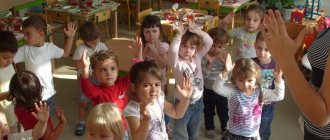Regular moments in the senior group in the afternoon
Summary of routine moments in the afternoon in the senior group “Forest Fairy Tale”.
MBDOU "Debesky kindergarten No. 1" Raising children
- Strengthen the ability to make a bed: straighten a sheet, cover it with a blanket;
- Improve the ability to dress and undress independently in a certain sequence;
- Formation of knowledge about a healthy lifestyle during awakening gymnastics;
Massage Mat
After the children begin to wake up, we begin awakening gymnastics. We use a complex of awakening gymnastics.
Preparing for afternoon tea
- develop self-service skills;
- Improve washing skills;
- form a CGN (wash hands before eating);
- Strengthen skills on duty: set the table with cutlery and dishes, napkins;
- To form the concept of a healthy lifestyle during rinsing and hygiene procedures in the bathroom.
Cups of salt water;
Teaching material: illustrations, board games
After all the girls have combed their hair, I suggest that all the guys brush their teeth and rinse their necks with a special solution of salt water. Goal: prevention of throat diseases.
I invite the dining room attendants to help set the table for afternoon tea.
Evening exercises after sleeping on the carpet, all together listening to music.
Evening circle. Children sit in a circle. Evening greeting. In a circle:
— finger gymnastics, “My Family”
One two three four
Who lives in our apartment?
Dad, mom, brother, sister, cat Murka, two kittens, my puppy, a cricket and me - that’s my whole family!
- articulation gymnastics,
“Smile” counting from 1 to 5 (hold)
“Tube” counting from 1 to 5 (hold)
Alternating “Smile”, “Tube”.
— Individual work with 5 children: pronouncing phrases,
didactic game for the development of speech and the formation of elementary mathematical concepts “Find the corresponding number and say it”
— physical education minute
Goal: getting children in the mood for the upcoming activity.
After the tables are set, I invite the children to wash their hands and come to the table.
I ask the children, what are we going to do now?, thereby fixing part of the day.
Afternoon snack
- improve skills: hold a fork with your thumb and middle finger, hold it on top with your index finger; eat different types of food without changing the position of the fork in your hand, but only slightly turning your hand.
- Improve the ability to cut a piece of cutlet (meat).
I remind you that you are not allowed to talk at the table.
When I eat
I don't listen to anyone
I pay attention to correct posture at the table while eating. Using my own example, I show you how to use cutlery correctly. I help the attendants read out the menu. I wish everyone a bon appetit.
I draw the children’s attention to the composition of the afternoon snack and the importance of each product for the child’s body (vitamins, minerals, etc.)
After an afternoon snack, I suggest rinsing your mouth with water. Purpose: preventive measure against caries.
Independent activities of children
Create conditions for the role-playing game “Shop”
- Control and observation of children during independent play activities.
Toys: dummies of vegetables and fruits, handbags, drawn money, cash register, counter, costumes for sellers, etc.
A gradual transition to the organization of a plot-role-playing game “Vegetable Store” or “Fruit Store” at the children’s choice. Offer the role of the seller to a low-active child in order to activate speech and communicate with peers, and perform the role until the end of the game. Buyers name the color and shape of an object in order to develop coherent speech. I pay attention to the children’s relationship with each other during the game.
Independent play activities for children in centers according to their wishes and interests.
Create conditions in the artistic corner:
- offer glue and scissors
- Goal: consolidation of application skills.
Ready-made templates and stencils, glue, scissors, visual material
I suggest some children do some applique work. As an example, I show an autumn leaf cut out of paper. I suggest choosing paper of any color you like and getting to work. I remind you that after working with glue you need to put everything back in its place.
Individual work with children
- Development of coordination of fine movements of the fingers
Sheet of paper and pencils
Game "Magic Pattern". I suggest coloring in view of the patterns. You need to decorate with pencils of different colors. I remind children how to hold a pencil correctly; do not go beyond the contours, etc.
Preparing for the walk
- Improve the ability to dress independently in a certain sequence;
- Strengthen the ability to properly place your things in the closet
- Educate KGN
I suggest the children go to the toilet. Let me remind you that boys come after girls.
Before going out to the locker room, we wait for “Silence”, then in such silence we get dressed gradually. I make sure that the children follow the sequence.
Exercise “Dress on command”: whoever is wearing tights and a sweater can wear pants. Now you can wear jackets and hats. Let me remind you that clothes need to be tucked inside to keep warm.
I give a positive assessment to children who dress correctly, quickly and quietly. I draw attention to those who need help.
Walk
Observation
- Form ideas about the autumn months;
- Learn to independently find signs of autumn in the environment;
- Systematize ideas about the state of plants in late autumn;
- vocabulary work: leaf fall, late autumn, short-term, herbarium;
While walking, I suggest that children observe seasonal changes in nature.
We highlight the weather features (in September it is colder than in August, rain, fog, the sun is shining but not warming). In November, late autumn sets in, there is snow on the ground.
We cultivate a caring attitude towards nature and plants.
Outdoor game “Tea-tea-help out”
(OVD - running)
- learn to act in harmony with each other.
- Learn to navigate in space
- Create positive emotions
I invite the children to gather in a circle and use a little counting rhyme:
On the golden porch sat the king, prince, king, prince, shoemaker, tailor, who are you, come out quickly, don’t detain good and honest people.
I'm getting the kids ready for a game. I remind you of the rules of the game. We choose a driver.
Individual work
- Sasha P – practice throwing at a target
Goal, ball
I suggest Sasha play “Hit the Target” ball. I explain how to hold and throw the ball. We train by doing several repetitions.
Goal: strengthening throwing skills.
Work assignments
- Learn to carry out the teacher's tasks
- Remove toys from the area
Broom, rake, gloves
Labor activity on site:
— Cleaning leaves;
— Sweeping on the veranda;
— We collect fallen leaves for the herbarium;
Working with parents
- Conversation about the child's achievements
When the children go home, I talk with the parents about the child’s achievements.
I suggest some parents pay attention to the child’s health, since he had a cough or runny nose during the day.
What is the importance of a kindergarten regime for a child?
If the daily routine in kindergarten corresponds to the age characteristics of the child, then it will help strengthen the baby’s health and also guarantee his good performance. At the same time, it provides a change in children’s activities and protects them from overwork. A child who gets used to the regime is prepared in advance for new activities, as a result of which they are more fruitful and effective. Children who follow a daily routine have a more stable psyche and are less prone to viral diseases.
When teachers plan the daily schedule in kindergarten, they first of all take into account the fact that the child’s activity and performance varies throughout the day. Children are most active from eight o'clock in the morning to twelve o'clock in the afternoon and from four o'clock in the afternoon to six o'clock in the evening. The minimum performance in children is from approximately two o'clock to four o'clock in the afternoon. Therefore, the first half of the day is devoted to developmental activities, taking into account the fact that children at this time can be actively involved in developmental activities.
| Performance in children | |
| highest | lowest |
| from 8:00 to 12:00 from 16:00 to 18:00 | from 14:00 to 16:00 after 20:00 |
Preschool educational institutions practice full compliance with the daily routine by children. However, parents can give some indulgences to their child on weekends, which cannot but affect his condition later. On Monday it is quite difficult for such children, as they get tired quickly.
Throughout preschool childhood, the regime in kindergarten undergoes only minor changes. The duration of daytime sleep and walking time change slightly.
Natasha / 2 half day mode
Analysis
regime processes in the afternoon
Raising children
1. During a gradual rise, the teacher communicates with the children. 2. The teacher creates conditions for children’s independent activity. 3. Conducts breathing exercises, attracts the attention of children. 4.Draws children’s attention to hygiene procedures; reinforces hand washing rules; talks about cleanliness. Evaluates children's activities; hand washing sequence; dressing sequence; exercises control over the appearance and neatness of the hairstyle. 6. The teacher creates a culture of behavior; friendly relationships with peers and adults.
Organization of independent play activities for children
The teacher communicates with children, conducts individual work and games.
Hygiene procedures
The teacher teaches children, under the supervision of adults, to wash their hands independently when they become dirty and before eating, talks about cleanliness; achieves a positive assessment of children's activities.
Afternoon snack
1. The teacher pays attention to the table setting; introduces children to the menu; attracts children's attention to the aesthetic design of tables. 2. Draws children's attention to food; carries out individual work to develop food culture skills; evaluates children's activities; cleaning tables.
Preparation for organized activities
Toy cleaning; switching children's attention to another type of activity; assessment of children's activities.
Organized activities
Free play activity for children
The teacher creates conditions for children’s independent play activities.
Preparing for the walk
1. Creating interest in the walk; individual conversations with children; selection of play material for a walk; motivation for children's activities during a walk. 2. Dressing: consistency, going for a walk.
Walk
1. The teacher organizes outdoor games: 2-3 games of high mobility; 2-3 games of low and medium mobility; for children's choice. 2. Conducts individual work on the development of movements and physical qualities: independent play activities; creating conditions for the development of role-playing games; games with natural materials; individual work on artistic activity, speech development; theatrical performances in the warm season; making snowmen. 3. Upon returning from a walk, the teacher controls the sequence of undressing the children and creates conditions for their free activity.
Hygiene procedures
During hygiene procedures, the teacher reinforces the rules of hand washing; conducts competitive games, talks about cleanliness; gives a positive assessment of children's activities.
Dinner
1. The teacher draws the children’s attention to the table setting: identifies those on duty; introduces children to the menu; attracts children's attention to the aesthetic design of tables. 2. Next, the teacher draws the children’s attention to food; carries out individual work to educate food culture; rules of etiquette; evaluates children's neatness.
Independent games for children. Farewell to children. Etiquette. Have a positive attitude the next day. Summing up the day.
One day in kindergarten, rough plan
Most preschool institutions work twelve hours (from 7.00 to 19.00). The daily routine in the kindergarten is drawn up accordingly: starting at seven in the morning, children are received, ending with them going home at seven in the evening.
- Morning. In the morning, the teacher receives children, conducts exercises and organized educational activities (classes) with them. Children also have breakfast in the morning, and in their free time they can play or chat with other children.
- Reception of children. The day begins with the teacher receiving the children from their parents. Here it is important to create a positive emotional mood among the guys in the entire group. When a teacher receives a child, he is interested in his state of health and can also answer some questions from parents.
- Morning work-out. In order to give children a boost of energy for the whole day, exercises are included in the kindergarten schedule in the morning, which involves a number of specific physical exercises. Daily exercises help strengthen the musculoskeletal system of children, making them more resilient and healthy. Exercises can be carried out either by the teacher himself or by a physical education worker. Usually, morning exercises are performed with musical accompaniment in the gym for physical education classes (except for nursery and junior groups).
- Breakfast. The daily routine in preschool educational institutions strictly regulates the time children eat, in particular, breakfast.
- Classes (educational activities). The teacher conducts classes in a playful way so that the children better understand the material. The duration of classes varies in different groups, taking into account the age of the children. On average they last from 10 to 25 minutes.
The daily routine of the kindergarten includes the following types of activities:
- cognitive development,
- mathematical development,
- speech development,
- familiarization with fiction,
- productive activities (modeling, design, appliqué),
- creative activity,
- music,
- Physical Culture.
- Day. The daily schedule of the kindergarten includes a walk, lunch and nap.
- The kindergarten routine certainly includes a daytime walk for children. It promotes children's health, hardening, development of movements and their general cognitive development. Usually, walks in kindergarten are carried out in any weather. The reasons for its cancellation are strong gusts of wind, heavy rain, heavy snowfall and blizzards, severe frost, etc. During drizzling rain and light snowfall, children walk on the verandas, which are specially provided for this purpose. In different age groups, the walk lasts its own specific time.
- After the walk, the children have lunch. In order to restore energy after cognitive and active activity, the child is offered to eat a full lunch, which consists of salad, first, second and third courses.
- Preschool children simply need daytime sleep, so it must be included in the daily routine in kindergarten. The duration of sleep depends on the age of the children. Typically, daytime sleep lasts from one and a half to three hours.
- Evening. Evening is considered to be the time after bedtime and before the children go home. During these hours, children have more time for independent play activities, and the teacher can carve out a few minutes for individual work with this or that child.
- After the children wake up, they go to lunch. This is a light snack that will help your child not feel hungry until dinner.
- For older children (senior and preparatory groups), an additional walk is included in the kindergarten schedule after afternoon tea.
- Educational activities are also provided in the evening. Classes are held in groups of younger and middle age. It could be modeling or drawing, music or physical education. In the evening, children are given more time for independent activities, role-playing or board games.
- Around five o'clock in the evening, the children sit down to dinner, and after that they begin to be taken home.
Daily routine in kindergarten for younger and older children
The daily routine in kindergarten differs for younger and older children. Teachers of younger groups pay more attention to the development of cultural and hygienic skills than directly to educational activities. The classes themselves are shorter here, lasting 10-15 minutes. The teacher conducts the lesson in subgroups. Children's walks are shorter in duration because a lot of time is spent on the process of dressing and undressing. Because of this, there are no walks for small children in the evening.
As children age, not only the difficulty of the activity increases, but also its duration. Therefore, there is less time for daytime sleep, and walking, on the contrary, increases.
Organizing a daily routine in a preschool educational institution is important for children. Parents should know how their child’s day is planned in kindergarten, and try to adhere to this schedule at home.




